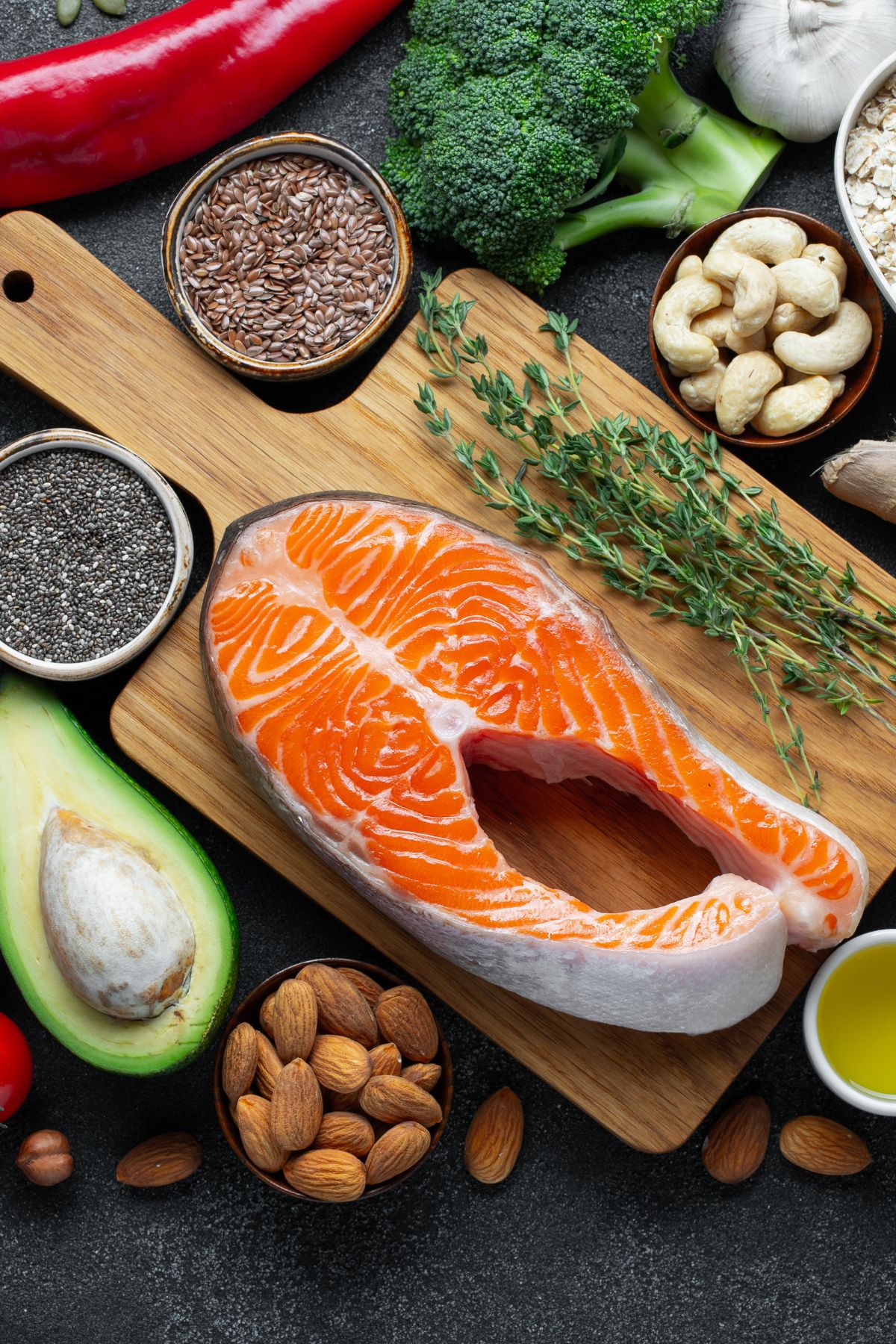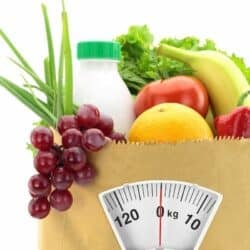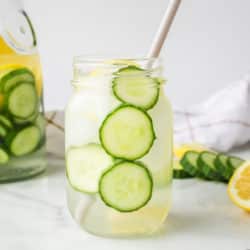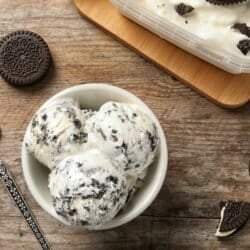Clean Eating Tips for Weight Loss (From a Nutritionist)
In this day and age, there are so many fad diets that come and go. Your best bet is to keep it simple and just eat more real foods and avoid the processed ones. In this blog post, I share helpful tips for clean eating for weight loss without feeling restricted or hungry. I also share a food list you can use to stock your kitchen.

If you’re tired of feeling confused about nutrition and trying to figure out which foods are “good” or “bad,” then it’s time to get back to a real food approach.
Clean eating simply means choosing less processed foods over more processed foods, plus adapting your choices to meet your individual needs.
It’s less of a strict diet, and more of a long-term lifestyle that will support overall health and balanced weight management.
How to Eat Clean for Weight Loss
Clean eating for weight loss does’t have to be complicated!
Here are some tips to get started with weight loss on a clean eating approach.
1. Start with cleaning up your diet
Consuming too many processed foods or restaurant foods can make it difficult to lose weight and may have other negative impacts on your health.
So, it’s important to take a good look at your diet and eliminate any elements that are hindering your weight loss journey.
Don’t have a lot of time to cook? Check out my list of pressure cooker recipes for weight loss.
Cut out foods containing added sugars.
Studies have shown that consuming too much sugar can contribute to obesity. Added sugar in foods has also been linked to type-2 diabetes and coronary heart disease.
Sources of sugar aren’t always obvious. Condiments and packaged foods often contain a lot of added sugars. An example are low-fat yogurts – any benefit from the reduction in fat is usually outweighed by their high sugar content.
But, you can still enjoy healthy treats. For example, try using fresh fruits or spices like cinnamon and nutmeg to add sweetness to clean desserts like natural yogurt.
Don’t lean on artificial sweeteners and diet sodas though.
Really try to stick with clean foods in their natural state for the best clean diet.
See my articles on how to do a sugar detox and a no-sugar diet meal plan.
Ditch processed foods in favor of clean, whole ingredients.
Processed foods are generally loaded with fats, sugars, and salt. These make them taste more appealing and are sometimes used to extend their shelf life. But, it’s easy to consume a large number of calories in a small amount of processed food without even realizing it.
Try to avoid “diet” beverages and aim to drink more water. If you don’t enjoy plain water, try infusing it with fresh fruit. My Cucumber Ginger Lemon Water is a healthy alternative!
You should also limit alcohol as much as possible. There are several ways in which it may stop you from losing weight.
- Some alcoholic drinks are high in calories, especially when combined with sweetened mixers.
- Drinking can interrupt your sleep cycle. This, in turn, affects your hormonal balance and influences your food intake and the amount of energy you expend.
- Too much alcohol can lead to poor food choices.
See my full clean eating shopping list and pantry guide to get started with a clean eating diet.
2. Set a realistic weight loss goal
While losing a lot of weight in a short period of time may seem appealing, setting the bar too high can lead to failure.
Restrictive diets are very hard to stick to for long, and they can damage your relationship with food. They can also slow down your metabolism!
The way to successfully lose weight is to find a diet that you enjoy, not one that causes stress and leaves you feeling miserable. This will ensure that don’t end up putting all that weight back on at a later date.
A realistic goal is to aim to lose around 1 to 2 pounds per week.
This is considered by experts to be safe, healthy, and sustainable. For some people, you may even need to set a goal of just ½ a week or even ½ pound every two weeks. Be sure to create weight loss goals that are achievable for you.
See my full list of weight loss tips for women for more helpful advice! And, if you have Hashimoto’s disease, then do read my article on how to lose weight with thyroid disease.
You might also like my article on a Pro-Metabolic Diet Plan if your metabolism is slow.
3. Get back to basics of meal planning and prep
As a nation we’ve got out of the habit of cooking with whole ingredients, relying instead on unhealthy convenience foods that are quick to prepare.
But cooking meals from scratch can help enormously in your weight loss journey. And it doesn’t need to be as time-consuming as you might think!
Choose recipes calling for fresh ingredients and whole foods. Then, cook in bulk for the week ahead. It can be tempting to grab a quick, unhealthy meal on a busy evening, but batch-cooking in advance means you’ll always have something nutritious to hand.
To make meal prepping easier, buy a dry-erase board for your kitchen and use it to note down meal/recipe ideas, listing the ingredients you’ll need. Get input from the rest of the family to create healthy meals that everyone will enjoy.
Make sure that you have a good supply of food storage containers in various sizes, including some made for travel. This will ensure you can take healthy, wholesome lunches to work, too.
See more of my meal prep tips for beginners, plus my list of appliances you need for a clean eating kitchen.
4. Enjoy balanced meals so you don’t get hungry between meals
Snacking between meals is one of the biggest barriers to weight loss. So it’s important to make sure your meals contain the right balance of nutrients to leave you feeling satisfied.
A balanced meal will contain foods rich in carbohydrates, healthy fats, and protein.
Avoid refined carbohydrates such as those in white foods like bread, pasta, and rice. These have been stripped of important elements like fiber, bran, and nutrients, leaving only “empty calories”.
Refined carbohydrates cause a spike in your blood sugar levels, followed by a sharp fall. The result is that you feel hungry again very quickly!
Instead, your carbohydrates should come from whole, nutrient-dense foods. Examples include whole foods like fruits, vegetables, legumes, and whole grains.
When it comes to lean proteins, you have lots of delicious choices. These include nuts, fish, lean meats, quinoa, eggs, legumes, dairy products (if tolerated), and seeds.
Finally, to increase satiety, make sure your meals incorporate healthy fats. Ditch trans and saturated fats in favor of healthy options like the fats from nuts, seeds, olives, fatty fish, and avocados.
If you want specific meal ideas and meal plans, check out these articles with clean eating breakfast ideas, foods to eat to be healthy, and easy clean eating recipes.
Or, try this Weight Loss Green Smoothie as a meal replacement option.
5. Reduce snacking
Snacking can become a habit, meaning that we reach for food between meals even when we are not hungry. This, of course, can be a real obstacle to weight loss.
Here are some techniques to help you cut back on excess snacking.
- Make a note of when you snack between meals and why then look for patterns in your behavior. You might notice that boredom or stress act as triggers, in which case you can look for alternative ways to deal with them.
- Drink a glass of water whenever you feel tempted to snack. It’s amazing how often we confuse hunger with thirst!
- Try chewing sugar-free gum. This has been proven to help regulate the appetite.
- Remove temptation by keeping foods out of sight.
If you are genuinely hungry, then choose a healthy treat like fruit, a small piece of dark chocolate, a few nuts, or homemade energy balls. Be prepared and make sure you have these natural foods readily available.
See my full list of the best gluten-free and dairy-free snacks.
6. Don’t skip meals
You might think that skipping meals makes it easier to lose weight.
If you skip a meal, you may end up so hungry that you are likely to binge. And because you’re so hungry, you’re less likely to think carefully about what you eat.
Going without a meal also prompts your body to burn fewer calories, lowering your metabolism to compensate for the lack of food. On top of all that, it can give you headaches and leave you feeling sluggish.
Eating at regular times keeps you fueled for the day and makes it easier to monitor your calorie intake.
Fasting or skipping meals can have other unintended health consequences. See my article about the dangers of intermittent fasting for women.
7. Consider increasing lean protein
When it comes to weight loss, protein is almost too good to be true!
First, it is proven to reduce the concentration of ghrelin in your body. Ghrelin is the hormone that makes you feel hungry. This is why eating a meal rich in protein leaves you feeling full.
But as an added bonus, protein also boosts your metabolism. This means eating protein-rich foods helps you burn more calories throughout the day.
The result is safe, natural weight loss, without the feeling that you’re missing out on anything.
Ideally, you should aim to include protein in every meal and snack. Instead of cereal for breakfast, pick foods like eggs, nut butter with whole grain toast, or unsweetened Greek yogurt. I love my Strawberry Protein Smoothie which packs in 25 grams per serving!
Throughout the day you can enjoy foods like fish, lean meats, poultry, tofu, and legumes. You’ll soon see that upping your protein is fairly easy – and the health benefits are more than worth the effort.
8. Prioritize sleep
Few of us realize just how important good sleep is when it comes to sustainable weight loss. But short sleep duration has been demonstrated to raise the risk of obesity in adults by a whopping 55%. That’s a significant increase and one to take very seriously when trying to lose weight without heavily restricting your diet.
When we don’t get enough sleep it affects the balance of our hormones, prompting cravings and increasing our appetite. It can also make us feel stressed which is, in itself, a trigger for over-eating.
You should be aiming for around 7 to 9 hours of sleep every night. Try to go to bed and get up at the same time each day.
If you struggle to sleep well, make sure that your bedroom is as dark and quiet as possible. Avoid looking at your phone or any other screen right before bed. If you’re a light sleeper, consider using a white noise app to mask the noises that might be disturbing you.
Getting enough quality sleep is a huge component of creating a healthy lifestyle that will improve overall health.
9. Do lab work including a full thyroid panel to rule out any medical causes of weight gain
It’s always a good idea to make sure that there is no medical issue contributing to your weight gain. No matter how much of a healthy diet you follow, it will be hard to achieve fat loss if your body is working against you.
Conditions like hypothyroidism, polycystic ovarian syndrome (PCOS), and Cushing’s syndrome can all make it hard to lose weight, as can certain types of medication.
Learn more about the best lab tests for women to help rule out medical issues that may be keeping you from losing weight. You might also like this article with reasons why you can’t lose weight no matter what.
If you still can’t figure out what is holding you back from healthy weight loss and feeling your best, then it might be time to consider a functional medicine practitioner who can help identify the root cause of your symptoms.
10. Do moderate exercise
Regular physical activity plays a part in helping you maintain a healthy weight. But this doesn’t need to feel like a chore! The most important thing is to find a type of exercise or activity that you really enjoy, then stick to it.
This can be anything from dance to yoga, or swimming to kickboxing. Pick any (or all) that you are happy to do regularly then aim to work out for around 30 minutes a day, 5 days a week. If you prefer, you can break the 30 minutes up into 3 x 10-minute sessions. This will help you meet the current Physical Activity Guidelines for Americans.
Despite the current emphasis on HIIT (high-intensity interval training) via the press and social media, you are more likely to be able to stick to continuous moderate-intensity exercise.
So, don’t feel like you need a punishing schedule in order to lose weight. Moderate exercise is both achievable and effective, and is a great way to improve energy levels.
If you have health disorders or pain, see my list of the best exercises for chronic health issues.
11. Get support to keep up motivation and celebrate the wins along the way
Being surrounded by supportive friends, family, or co-workers can make it so much easier to stick to a clean-eating diet. Having someone with whom you can discuss your goals and progress helps you feel motivated and also makes you accountable.
If you don’t have support in your day-to-day life then consider seeking it online. Facebook is home to hundreds of groups of like-minded individuals helping others achieve their goals and celebrating successes.
You can join my Clean Eating Private Facebook group or find similar ones.
Clean Eating Foods for Weight Loss
Here is a solid list of healthy foods you can add to your shopping list that can support moderate weight loss and healthy weight management.
This list is most gluten-free and dairy-free, but you can adapt it to your dietary needs.
- Lean proteins: chicken, turkey, fish, tofu, tempeh, legumes (beans, lentils, chickpeas), egg, turkey bacon, turkey sausage, lean beef, pork tenderloin, lamb, bison, venison
- Dairy products (if you tolerate dairy products): Milk, yogurt, kefir (try to choose low-sugar options)
- Non-starchy vegetables: leafy greens (spinach, kale, collard greens, lettuce, arugula), broccoli, bell peppers, tomatoes, zucchini, cauliflower, mushrooms, asparagus, Brussels sprouts, eggplant, onions, garlic, carrots, sweet potatoes, winter squash (acorn, butternut, spaghetti), beets, radishes, turnips, parsnips, rutabagas, celery, fennel, okra, artichokes, leeks, radicchio, endive, escarole, watercress
- Fruits: berries (strawberries, raspberries, blueberries, blackberries, cranberries), apples, pears, citrus (oranges, lemons, grapefruits, tangerines, clementines, kumquats), bananas, mangoes, melons (watermelon, cantaloupe, honeydew), kiwi, papaya, pineapple, peaches, plums, apricots, grapes, applesauce (unsweetened)
- Gluten-free grains: quinoa, brown rice, oats, rice noodles, rice pasta, corn pasta, quinoa pasta, quinoa flakes, cornmeal, polenta, corn tortillas
- Healthy fats: avocado, nuts and seeds (almonds, cashews, chia seeds, flax seeds, pumpkin seeds, sunflower seeds, sesame seeds, pine nuts), olive oil, coconut oil, almond butter, peanut butter (natural), tahini, flaxseed oil, avocado oil, sesame oil
- Herbs and spices: basil, cilantro, parsley, rosemary, thyme, oregano, marjoram, paprika, cumin, chili powder, cinnamon, turmeric, ginger, garlic powder, onion powder, sea salt, black pepper, coriander, cardamom, cloves, nutmeg, allspice, cayenne pepper, mustard seeds, fennel seeds
- Drinks: water, unsweetened iced tea, unsweetened coffee, unsweetened almond milk, unsweetened coconut milk, unsweetened soy milk, green tea, herbal tea, low-sugar sports drinks
- Snacks: raw vegetables (carrots, bell peppers, cucumbers, cherry tomatoes), hummus, hard-boiled eggs, turkey jerky, unsweetened applesauce, unsalted nuts and seeds, air-popped popcorn, rice cakes, protein bars (without added sugars or dairy), protein shakes, smoothies (made with unsweetened milk or yogurt and fruit)
Clean Eating Weight Loss FAQs
Did you know that your body actually tries to prevent you from losing weight?
When you lose weight, your levels of the hormone leptin begin to fall. Your brain – thinking you are full – increases the production of the hunger hormone ghrelin in response. The result? You start eating too much again, and the cycle continues.
Your metabolism can be problematic, too. If you cut down significantly on your calories, your metabolism slows down, so your body doesn’t burn them as efficiently. The best way to avoid your body trying to hang on to all that fat is to approach weight loss carefully. That means gradually reducing your calorie intake, and enjoying regular- but moderate – exercise.
Counting calories is hard work and difficult to sustain for long periods of time. Clean eating, however, is a philosophy that’s easy to incorporate into your daily life.
Its emphasis on whole, nutritious ingredients – with plenty of lean protein and healthy carbs and fats – naturally supports your metabolism and ensures it functions as it should. This – along with regular physical activity – will help you maintain a healthy weight without leaving you hungry. It will also ensure you have the energy you need for your day-to-day activities.
Learn more about how to eat clean including a 7-day meal plan.
Unless you have been advised by a doctor to avoid carbohydrates, then you can and should be eating whole, unrefined sources of carbohydrates, including fruits and vegetables. Our bodies break carbohydrates down into glucose, our main source of energy.
But the key is consuming high-quality carbs, as opposed to the processed carbs in white bread, sweetened cereal, cakes, pizza, etc. Carbohydrates from processed foods cause blood sugars to spike and then drop, often prompting you to eat more.
But high-quality carbohydrates – from foods like fruits, vegetables, and legumes – release glucose into your blood much more slowly. These help keep you full for longer, which actually supports weight loss. They also provide other valuable nutrients, including minerals, vitamins, and fiber.
Don’t Miss These Clean Eating Resources
Conclusions
It’s a myth to think that drastically cutting calories is the only route to weight loss. As you’ve seen, it can actually be counter-productive and lead to changes in the metabolism that make it even harder to lose weight in the long term.
Clean eating is a far more measured approach and one that you can follow for life. A diet rich in wholesome, healthy ingredients is the best way for you to reach your goal weight and enjoy the process!
Don’t forget to join my newsletter list to get exclusive clean eating recipes and tips. The newsletter is 100% free with no spam; unsubscribe anytime.
About the Author: Carrie Forrest has a master’s degree in public health with a specialty in nutrition and is a certified holistic nutritionist. She is a top wellness and food blogger with over 5 million annual visitors to her site. Carrie has an incredible story of recovery from chronic illness and is passionate about helping other women transform their health. Send her a message through her contact form.
Note: this post is for informational purposes only and is not intended as medical advice. Please consult your healthcare provider for recommendations related to your individual situation.





















This is a great article! Thorough, but concise! Thank you!